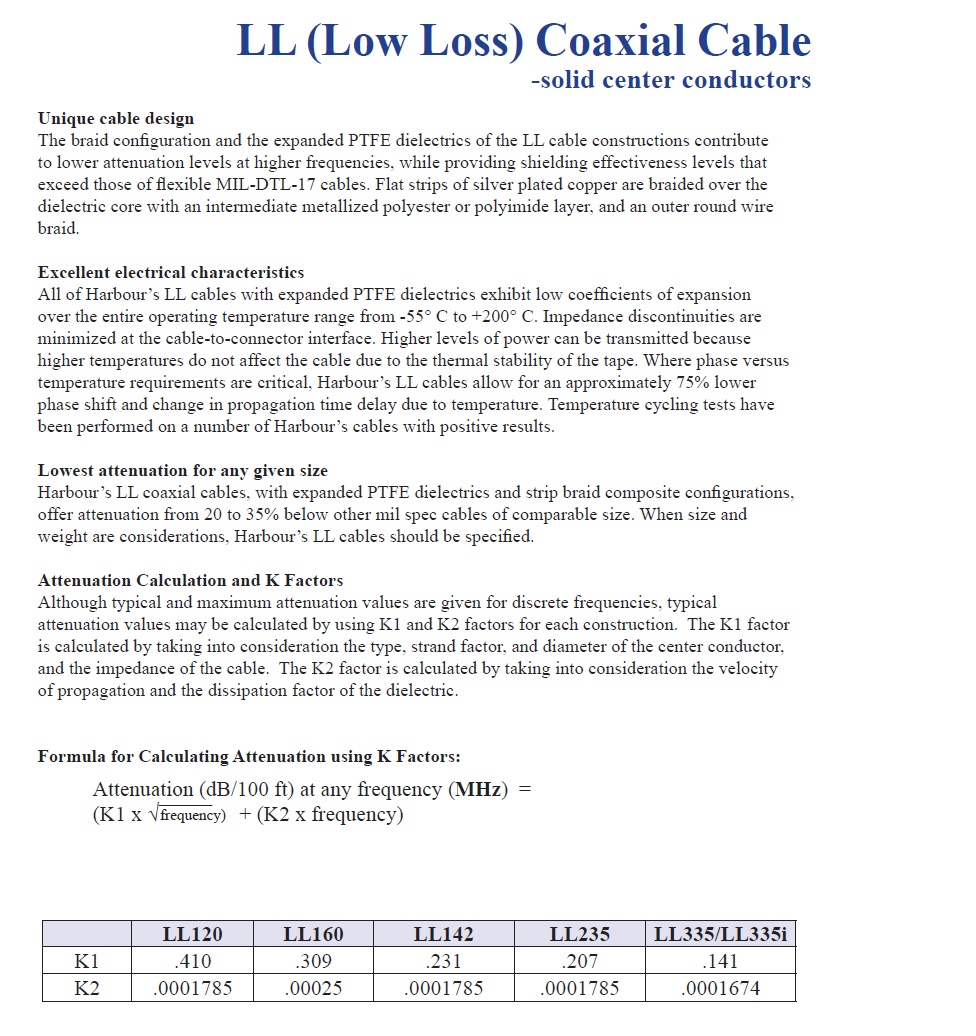LL (Low Loss) Coaxial Cable -solid center conductors
Construction: Center Conductor: Solid silver plated copper Dielectric: Expanded PTFE tape Inner Braid: Flat silver plated copper strip Inter layer: Aluminum polyester or polyimide tape Outer Braid: Round silver plated copper Jacket: FEP, translucent colors, solid colors or clear
Operating temperature -55 +200° C Velocity of Propagation 80%-83% Impedence 50 Ohms Capacitance 25.0 pF/ft Shielding Effectiveness <-95 dB
LL120 LL160 LL142 LL235 LL335 LL335i
Unique cable design The braid configuration and the expanded PTFE dielectrics of the LL cable constructions contribute to lower attenuation levels at higher frequencies, while providing shielding effectiveness levels that exceed those of flexible MIL-DTL-17 cables. Flat strips of silver plated copper are braided over the dielectric core with an intermediate metallized polyester or polyimide layer, and an outer round wire braid.
Excellent electrical characteristics All of Harbour’s LL cables with expanded PTFE dielectrics exhibit low coefficients of expansion over the entire operating temperature range from -55° C to +200° C. Impedance discontinuities are minimized at the cable-to-connector interface. Higher levels of power can be transmitted because higher temperatures do not affect the cable due to the thermal stability of the tape. Where phase versus temperature requirements are critical, Harbour’s LL cables allow for an approximately 75% lower phase shift and change in propagation time delay due to temperature. Temperature cycling tests have been performed on a number of Harbour’s cables with positive results.
Lowest attenuation for any given size Harbour’s LL coaxial cables, with expanded PTFE dielectrics and strip braid composite configurations, offer attenuation from 20 to 35% below other mil spec cables of comparable size. When size and weight are considerations, Harbour’s LL cables should be specified.
Attenuation Calculation and K Factors Although typical and maximum attenuation values are given for discrete frequencies, typical attenuation values may be calculated by using K1 and K2 factors for each construction. The K1 factor is calculated by taking into consideration the type, strand factor, and diameter of the center conductor, and the impedance of the cable. The K2 factor is calculated by taking into consideration the velocity of propagation and the dissipation factor of the dielectric.
Formula for Calculating Attenuation using K Factors: Attenuation (dB/100 ft) at any frequency (MHz) = (K1 x √¯¯¯¯¯ + (K2 x frequency) LL120 LL160 LL142 LL235 LL335/LL335i K1 .410 .309 .231 .207 .141 K2 .0001785 .00025 .0001785 .0001785 .0001674 frequency)
keyword: Harbour, LL142, 18Ghz Coaxial Cable,LL120, LL160, LL142, LL235, LL335, RG142,低損耗同軸電纜-單股中心導體, 宜大電線, BELDEN, ALPHA, google, times, lmr

Harbour-LL142-solid

 2024/5/3 下午 09:07:14
2024/5/3 下午 09:07:14











